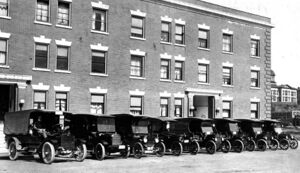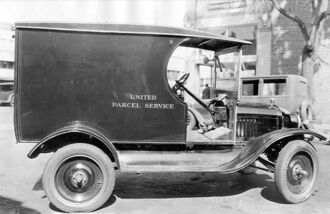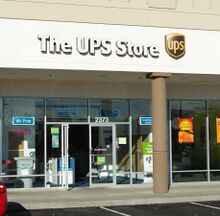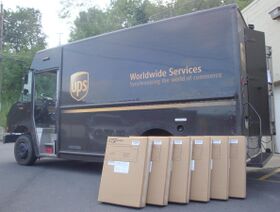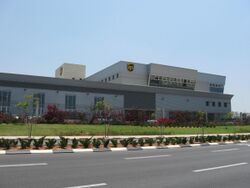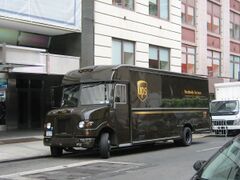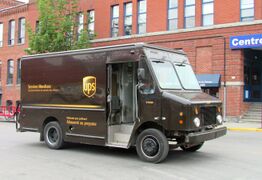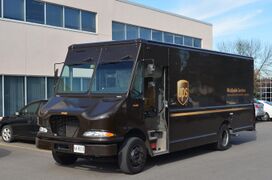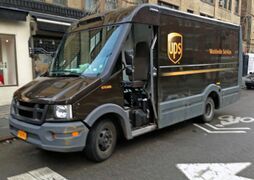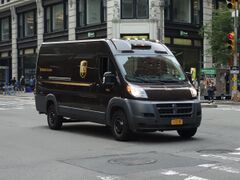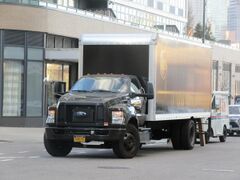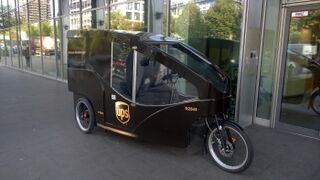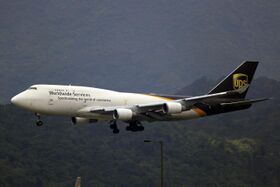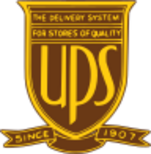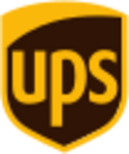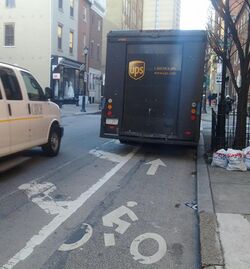United Parcel Service
Topic: Company
 From HandWiki - Reading time: 27 min
From HandWiki - Reading time: 27 min
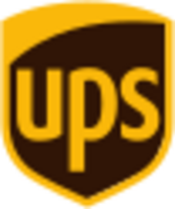 | |
| Formerly | American Messenger Company |
|---|---|
| Type | Public |
| Industry | Courier |
| Founded | August 28, 1907 in Seattle, Washington, U.S. as the American Messenger Company |
| Founder | James E. Casey |
| Headquarters | Sandy Springs, Georgia, U.S. |
Area served | Worldwide |
Key people | Carol B. Tomé (CEO) |
| Services | |
| Revenue | |
| Total assets | |
| Total equity | |
Number of employees | 536,000 (2022) |
| Subsidiaries |
|
| Website | ups |
| Footnotes / references [1][2][3][4][5] | |
United Parcel Service, Inc. (UPS) is an American multinational shipping & receiving and supply chain management company founded in 1907.[1] Originally known as the American Messenger Company specializing in telegraphs, UPS has grown to become a Fortune 500 company[6] and one of the world's largest shipping couriers. UPS today is primarily known for its ground shipping services as well as the UPS Store, a retail chain which assists UPS shipments and provides tools for small businesses. UPS offers air shipping on an overnight or two-day basis and delivers to post office boxes through UPS Mail Innovations and UPS SurePost, two services that pass on packages to the United States Postal Service for last-mile delivery.[7][8]
UPS is the largest courier company in the world by revenue, with annual revenues around US$85 billion in 2020, ahead of competitors DHL and FedEx.[9] UPS's main international hub, UPS Worldport in Louisville, Kentucky, is the fifth busiest airport in the world by cargo traffic based on preliminary statistics from ACI, and the third busiest in the U.S. behind FedEx's Memphis Superhub and Ted Stevens Anchorage International Airport.[10] The company is one of the largest private employers in the United States.[11]
History
Foundation
On August 28, 1907, James E. Casey founded the American Messenger Company with Claude Ryan[12] in Seattle, Washington,[13] capitalized with $100 in debt.[14] Most deliveries at this time were made on foot and bicycles were used for longer trips.
The American Messenger Company focused primarily on package delivery to retail stores with special delivery mail delivered for its largest client the U.S. Post Office. In 1913, the company acquired a Model T Ford as its first delivery vehicle. Casey and Ryan merged with a competitor, Evert McCabe, and formed Merchants Parcel Delivery. Consolidated delivery was also introduced, combining packages addressed to a certain neighborhood onto one delivery vehicle.[14]
In 1916, Charlie Soderstrom joined Merchants Parcel Delivery bringing in more vehicles for the growing delivery business. In 1919, the company expanded for the first time outside of Seattle to Oakland, California, and changed its name to United Parcel Service.[15]
The common carrier service was acquired in 1922 from a company in Los Angeles , California. UPS became one of the only companies in the United States to offer common carrier service. At first, common carrier was only limited to a small area around Los Angeles but by 1927 expanded to areas up to 125 miles outside the city. In 1924, a conveyor belt system was debuted for the handling of packages for UPS operations.[16]
In 1930, a Template:Clarification needed span began in New York City, and soon after in other major cities in the East and the Midwest.[17] The use of common carrier for delivery between all customers placed UPS in direct competition with USPS, and delivering parcels beyond the California border brought it under the jurisdiction of the Interstate Commerce Commission. The first city for UPS to use common carrier status outside California was Chicago, Illinois, in 1953.[18]
Air service through UPS was first used in 1929 through private airlines. However, the Great Depression and a lack of volume ended the service. In 1953, UPS resumed air service called UPS Blue Label Air with two-day service to major cities along the East Coast and West Coast.[19]
Expansion and diversification
In 1975, UPS moved its headquarters to Greenwich, Connecticut, and began serving all of the 48 contiguous states of the United States. This expansion of operations made UPS the first package delivery company to serve every address in the contiguous United States. Additionally in 1975, UPS went international by establishing operations in Canada.[20] In 1976, UPS established a domestic operation in West Germany.[21]
UPS Next Day Air Service was launched in 1985 for all 48 contiguous states plus Puerto Rico. In 1988, UPS Airlines was launched with authorization from the Federal Aviation Administration and became the fastest-growing airline in FAA history – currently the 10th largest airline in the United States.[22] Domestic air service was added to Germany in 1989.[23] In 1991, UPS relocated its headquarters to Sandy Springs, Georgia, a suburb of Atlanta. Following this in 1992, UPS acquired both Haulfast and Carryfast and rebranded them UPS Supply Chain Solutions. Haulfast provided the pallet haulage and trucking network for the CarryFast group of companies. By 1993, UPS was delivering up to 11.5 million packages and documents per day.
In order for the company to service the large volume of customers in 1991, UPS developed technologies to improve efficiency. A handheld device called "Delivery Information Acquisition Device" (DIAD) was created to record and upload delivery information to the UPS network immediately upon pickup by every UPS driver.[24] In 1992, UPS began tracking all ground shipments electronically. In 1994, UPS.com debuted, and provided an interface to make what was primarily internal operational information available for customer access. After 27 years of providing this information, UPS chose to hide it again for most packages in 2021 and this information is no longer available on their consumer facing website.
In 1995, UPS acquired SonicAir to offer service parts logistics and compete with Choice Logistics.[25] In the same year, UPS launched UPS Logistics Group to facilitate global supply chain management services and consulting for customer needs. In 1997, a walkout by the 185,000 members of the Teamsters shut down UPS for 16 days.[26] In 1998, UPS Capital was established to enable companies to grow their business through a comprehensive menu of integrated financial services through UPS.[27] UPS acquired Challenge Air in 1999 to expand its operations in Latin America.[28]
On November 10, 1999, UPS became a public company[29] in the largest initial public offering of the 20th century.[30]
21st century
In 2001, UPS acquired Mail Boxes Etc., Inc., a franchised network of packing and shipping retail centers across the United States and Canada.[31] In 2003, the company rebranded the Mail Boxes, Etc. network as The UPS Store.
In 2004, UPS entered the heavy freight business with the purchase of Menlo Worldwide Forwarding, a former subsidiary of Menlo Worldwide; UPS rebranded it as UPS Supply Chain Solutions. The purchase price was US$150 million and the assumption of US$110 million in long-term debt.
On August 5, 2005, UPS announced that it has completed its acquisition of less-than-truckload (LTL) trucking company Overnite Transportation for US$1.25 billion.[32] This was approved by the FTC and Overnite shareholders on August 4, 2005. On April 28, 2006, Overnite officially became UPS Freight.
In 2005, UPS offered non-stop delivery service between Guangzhou and the United States.[33] On October 3, 2005, UPS completed the purchase of Lynx Express, one of the largest independent parcel carriers in the United Kingdom, for £55.5 million (US$97.1 million) after receiving approval for the transaction from the European Commission. The first joint package car center operation in Dartford, Kent, was opened in 2006.
On August 28, 2007, United Parcel Service celebrated its 100th anniversary.[34] All Nippon Airways, a Star Alliance member, and UPS formed a cargo alliance and code-share to transport member cargo in 2008, similarly to an airline alliance.[35]
On March 19, 2012, UPS announced that it intended to acquire TNT Express for $6.8 billion, in a move to help expand its presence in European and Asian markets.[36] However, the deal fell through in January 2013, after it was announced that UPS had failed to obtain permission from the European Commission and as such had been blocked on competition grounds.[37]
In February 2012, UPS acquired Brussels-based company Kiala that provides e-commerce retailers the option to have goods delivered to a conventional retail location.[38]
In 2018, The Wall Street Journal reported that UPS's operations were hampered by its outdated 20th-century technology, lagging behind its competitors.[39]
In May 2019, UPS launched a partnership with autonomous trucking startup, TuSimple to carry cargo across Phoenix, Arizona, and Tucson, Arizona.[40]
In October 2019, UPS won the approval of the Federal Aviation Administration to fly drones.[41] The certification will allow UPS to deliver health care supplies using a fleet of drones.[42]
On January 29, 2020, UPS announced it was investing in UK start-up Arrival and ordering 10,000 Generation 2 electric vehicles as a step towards a cleaner, more high-tech fleet. The deal runs from 2020 until 2024 and was reported to be worth more than $400 million.[43]
In March 2020, the company has appointed Carol Tomé to succeed David Abney as its chief executive officer. It was viewed as a move to steer the parcel delivery company through the turbulence of trade wars, technological disruption and the risk of a pandemic-induced recession.[44]
In March 2020, UPS expands its autonomous trips with TuSimple by adding an extra route between Phoenix and El Paso, Texas.[45]
In January 2021, UPS announced it had agreed to sell UPS Freight, its less-than-truckload freight business, to TFI International, a Canadian transport and logistics company, for $800 million. UPS said the move would allow it to focus on small-package delivery. At the time of the sale, UPS Freight had about 14,500 employees, approximately 11,000 of them represented by the Teamsters union, and generated an estimated $3.15 billion in revenue in 2020 offering services across the US, Canada, and Mexico. TFI had reported $4.1 billion in revenue in 2019 and already operated truckload and LTL services in Canada.[46] The acquisition was completed in April and UPS Freight was renamed TForce Freight.[47]
In 2021, following the company's shift to target smaller customers to boost profits during the COVID-19 pandemic, UPS reported a 21% jump in their fourth quarter sales to $24.9 billion. CEO Carol Tomé reported that Amazon paid UPS $11.3 billion in shipping in 2020, accounting for 13.3% of the company's revenue.[48]
In September 2021, UPS entered into an agreement to acquire Roadie for an undisclosed amount with the transaction expected to be closed in the fourth quarter.[49]
In November 2022, it was announced UPS had acquired the healthcare focused, Europe-based warehousing and temperature-controlled transport company, Bomi Group.[50]
In September 2023, it was announced UPS had acquired the Long Beach, California-headquartered time-critical, health care logistics company, MNX for an undisclosed amount.[51]
In October 2023, it was announced UPS had acquired the Los Angeles -headquartered reverse logistics company, Happy Returns from PayPal for an undisclosed amount.[52]
In January 2024, UPS announced that it planned to cut 12,000 jobs and mandate that staff return to the office five days a week. Chief Executive Carol Tomé blamed the move on a "difficult and disappointing year" in 2023.[53]
Operational facilities
United States
Louisville UPS Worldport
UPS’ global hub for air shipments Is the Worldport, located at Louisville Muhammad Ali International Airport. The facility contributes to the airport's status of the second-busiest cargo airport in the United States and the fourth-busiest worldwide.[54][55]
The Worldport consist of:
- 290 aircraft;
- more than 20,000 employees;
- 5.2 million square feet of building space (about 90 football fields).[56][55]
- the capacity to handle 115 packages per second (equivalent to 416,000 packages flowing through its facilities every hour);
Regional air hubs
UPS has five large regional air hubs in the United States, located in Ontario, California; Dallas, Texas; Rockford, Illinois; Philadelphia, Pennsylvania; and Atlanta, Georgia. These hubs serve as centers for sorting, transfer and delivery of packages.[57]
Europe
Poland
UPS has established a 11,000 square meter package center in Mysłowice. The facility is equipped with a conveyor belt system capable of sorting up to 6,000 packages per hour. It also offers parking for 170 package cars and houses a customer call center. The size of the Mysłowice facility is more than three times larger than the one in Katowice. Mysłowice was chosen as the location for the new facility in 2017 due to its proximity to various business distribution centers and Katowice airport, where UPS has invested in additional air cargo capacity.[58]
Turkey
UPS has 15 small package and 4 SCS operating facilities in Turkey, located in various cities such as Istanbul, Ankara, Izmir, Bursa, and Antalya.[59]
Asia-Pacific Region
Asia-Pacific Air Hub
UPS's Asia-Pacific Air Hub is located at Singapore Changi Airport. It is the company's largest hub outside of the United States, and handles over 1.1 million packages per day.[60][61] The hub has been expanded by 25% in 2023 to meet the growing e-commerce demand following the pandemic. After the upgrade, it can process 40% more import packages and 45% more export packages, enabling extended pick-up cut-off times for all export services.[60]
The hub also features refrigerators and freezers that can maintain temperatures between −20 and 25 °C (−4 and 77 °F) to facilitate the temporary storage of shipments, especially for critical healthcare deliveries such as COVID-19 vaccines. It is part of Changi's cold chain infrastructure, which ensures an unbroken cold chain for pharmaceutical manufacturers.[61]
Regional hubs
UPS has five regional hubs in the Asia-Pacific region, located in Hong Kong, Japan , Korea, Malaysia, and Thailand. These hubs serve as major sorting and distribution centers for packages moving within and between regions.[62]
Finances
This section may contain an excessive amount of intricate detail that may interest only a particular audience. (January 2021) (Learn how and when to remove this template message) |
For the fiscal year 2022, UPS reported earnings of US$11.55 billion, with an annual revenue of US$100.34 billion, an increase of 3% over the previous fiscal cycle.[1] UPS ranked No. 34 on the 2022 Fortune 500 list of the largest United States corporations by total revenue.[63]
| Year | Revenue in mil. USD |
Net income in mil. USD |
Total Assets in mil. USD |
Employees |
|---|---|---|---|---|
| 2005 | 42,581 | 3,870 | 34,947 | 407,000 |
| 2006 | 47,547 | 4,202 | 33,210 | 428,000 |
| 2007 | 49,692 | 382 | 39,042 | 425,300 |
| 2008 | 51,486 | 3,003 | 31,879 | 426,000 |
| 2009 | 45,297 | 1,968 | 31,883 | 408,000 |
| 2010 | 49,545 | 3,338 | 33,597 | 400,600 |
| 2011 | 53,105 | 3,804 | 34,701 | 398,000 |
| 2012 | 54,127 | 807 | 38,863 | 399,000 |
| 2013 | 55,438 | 4,372 | 36,212 | 395,000 |
| 2014 | 58,232 | 3,032 | 35,440 | 435,000 |
| 2015 | 58,363 | 4,844 | 38,311 | 444,000 |
| 2016 | 60,906 | 3,431 | 40,377 | 434,000 |
| 2017 | 65,872 | 4,910 | 45,403 | 454,000 |
| 2018 | 71,861 | 4,791 | 50,016 | 481,000 |
| 2019 | 74,094 | 4,440 | 57,857 | 495,000 |
| 2020 | 84,628 | 1,343 | 62,408 | 458,000 |
| 2021 | 97,287 | 12,890 | 69,405 | 534,000 |
| 2022 | 100,338 | 11,548 | 71,124 | 536,000 |
Operations
UPS's primary business is the time-definite delivery of packages and documents worldwide. In recent years, UPS extended its service portfolio to include LTL transportation (primarily in the U.S.) and supply chain services.[citation needed]
UPS reports its operations in three segments:
- U.S. Domestic Package operations,
- International Package operations, and
- Supply Chain & Freight operations.
United States domestic shipping
UPS services for consumers include:
- UPS Ground for day-definite delivery. Can take up to 5 days.[64]
- UPS 3-Day Select for less-sensitive express shipments. This service may use either air or ground transportation depending on distance, demand, and weather conditions, and as noted by its name, can take up to three days.[65]
- UPS 2nd Day Air for packages that must arrive within two days. UPS also offers a 2nd Day Air AM service which offers morning delivery.[66][67]
- UPS Next Day Air for shipments that require overnight service. UPS splits Next Day Air into three tiers:
- UPS Express Critical: UPS' fastest service. Delivers to all 50 states, DC, and Puerto Rico by end of day.[71]
UPS also offers UPS SurePost, in which packages are handled by UPS in intermodal transit, and delivered last-mile by USPS.[7]
International Package
International Package operations include delivery to more than 220 countries and territories worldwide,[72] including shipments wholly outside the United States, as well as shipments with either origin or distribution outside the United States.
UPS splits its international shipping into a few services:
- UPS Standard for shipments to Mexico and Canada [73]
- UPS Worldwide Expedited for all international shipments usually delivered within 2-5 business days[74]
- UPS Worldwide Saver, also for all international shipments usually delivered overnight to Canada, 2 Days to Mexico, Latin America, and Europe, and 3 or more days to the rest of the world, all by the end of the day.[75]
- UPS Worldwide Express for more critical international shipments with similar time frames to Worldwide Saver. Delivers around 10:30 AM to Noon.
- UPS Worldwide Express Plus for Worldwide Express shipments that need to arrive to their destination earlier in the morning.[76]
Supply Chain & Freight
Supply Chain & Freight (UPS-SCS for UPS Supply Chain Solutions) includes UPS' forwarding and contract logistics operations and other related business units. UPS' forwarding and logistics business provides services in more than 175 countries and territories worldwide and includes worldwide supply chain design, execution and management, freight forwarding and distribution, customs brokerage, mail and consulting services.
Other business units within this segment include The UPS Store and UPS Capital.[77]
- Trailer / railroad reporting marks: UPGX, UPGZ, UPOZ, UPSZ, UPWZ, UPSC, UPSU, NONZ [78]
- NMFTA SCAC code: UPSS, UPSN, UPSC
Until 2021, this segment also included UPS Freight which offered a variety of less than truckload ("LTL") and truckload ("TL") services to customers in North America. UPS Freight was sold to TFI International in April 2021 and was renamed TForce Freight.[46][47]
Personnel structure
In 2016 UPS employed approximately 444,000 staff: 362,000 in the U.S. and 82,000 internationally.[79] In 2023 approximately 330,000 UPS drivers, package handlers, and clerks are represented by the International Brotherhood of Teamsters with more than 50% of those being part-time workers.[80][81] In 2023, the average UPS full-time package delivery worker with more than four years experience was paid $95,000 per year.[80]
During the United Parcel Service strike of 1997, the company's only nationwide strike in its history, which lasted 16 days, Teamster President Ron Carey negotiated a new contract for workers.[82] In July 2023, before their contract was set to expire, a strike was threatened over union demands of increases in wages, benefits, and air conditioning in delivery vans.[83][84][85] A 10-day strike would have been the largest single-employer strike in US history and would have cost the US economy more than $7 billion.[86][84][81] The strike was called off after UPS agreed to increase starting pay for part-time workers to $21 per hour, in addition to other concessions.[81] UPS had previously announced the non-economic portions of the agreement had been settled, including to equip new delivery vans with air conditioning starting January 2024 combined with retrofitting existing vehicles with 2 fans, additional ventilation of the cargo area and shielding to reduce heat from the exhaust being transmitted to the cargo area of delivery vehicles. All tractor trailers are already equipped with AC.[87][88]
Chief executives
- 1907–1962, James E. "Jim" Casey
- 1962–1972, George D. Smith
- 1972–1973, Paul Oberkotter
- 1973–1980, Harold Oberkotter
- 1980–1984, George Lamb
- 1984–1989, John W. Rogers
- 1989–1996, Kent C. "Oz" Nelson
- 1997–2001, James P. Kelly
- 2002–2007, Michael L. "Mike" Eskew
- 2008–2014, Scott Davis[89]
- 2014–2020, David Abney
- 2020–current, Carol B. Tomé
Competitors
Major competitors in the United States include the United States Postal Service (USPS) and FedEx, along with regional carriers such as OnTrac, and LSO (formerly Lonestar Overnight). In addition to these domestic carriers, UPS competes with a variety of international operators, including SF Express, Canada Post (and its subsidiary Purolator), TransForce, Deutsche Post (and its subsidiary DHL), Royal Mail, Japan Post Service, and many other regional carriers, national postal services and air cargo handlers (see Package delivery and Mail pages).
Historically, the bulk of competition for UPS came from inexpensive ground-based delivery services, such as Parcel Post (USPS) or Choice Logistics. In 1998, FedEx expanded into ground parcel delivery through its acquisition of RPS (formerly Roadway Package System), rebranding it as FedEx Ground in 2000. In 2003, DHL acquired Airborne Express, expanding its operations in the United States.
In response to the expansion of FedEx and DHL, UPS partnered with the US Postal Service to offer UPS Mail Innovations,[90] a program that allows UPS to pick up mail and packages weighing under one pound separately from the main ground network and transfer them to a USPS center, or destination delivery unit (DDU),[91] for final distribution. This process is also known as zone skipping,[92] long used by parcel consolidators.[93] UPS also has a separate product called "SurePost" which uses the UPS Ground network to deliver packages weighing under 10 pounds to the nearest UPS Package Center, which transfers them to the USPS DDU for "final mile" delivery.[94]
More recently, the continued growth of online shopping, combined with increasing awareness of the role of transportation (including package delivery) on the environment, has contributed to the rise of emerging competition from niche carriers or rebranded incumbents. For instance, the US Postal Service claims "greener delivery" of parcels on the assumption that USPS letter carriers deliver to each US address, six days a week anyway, and therefore offer the industry's lowest fuel consumption per delivery. Other carriers, like ParcelPool.com,[95] which specializes in residential package delivery to APO/FPO addresses, Hawaii, Alaska, Puerto Rico, and other US Territories, arose in response to increased demand from catalog retailers and online e-tailers for low-cost residential delivery services closely matching service standards normally associated with more expensive expedited parcel delivery.
In 2019, UPS sued in an attempt to force USPS to raise their prices, but was rejected by the Supreme Court.[96]
Transportation
UPS operates over 119,000 delivery vehicles worldwide, ranging from bicycles to tractor-trailer trucks.[97] In a long-running company policy to avoid advertisement or endorsement of a vehicle manufacturer, all external manufacturer emblems and badging are removed when a vehicle enters service (whenever possible).
The typical lifespan of a UPS ground vehicle is 20–25 years (or more), lasting until the structural integrity is compromised. The company does not re-sell any of its ground vehicles, so retired vehicles are almost always stripped of reusable parts before being sent to be crushed/broken up. Prior to scrapping, UPS trucks and trailers have all company branding painted over and are assigned an ADA (Automotive Destruction Authorization) number and must be crushed under the supervision of UPS Automotive personnel, which records the vehicle's destruction. The only exception to this policy are vehicles taken off the road for internal company use; package cars (repainted white) are used for various purposes (typically at large hubs); older semi tractors sometimes see use as terminal tractors.
Delivery vans
UPS refers to its delivery van as a "package car". Several designs and sizes are used by the company, dependent on routes and package volume; the distinct design of the rounded "bubble-nose" front hood and upper roofline was introduced in 1965. The bodies of the package cars are manufactured by Morgan Olson (Grumman Olson), Union City Body, and Utilimaster; while older vehicles were based on Ford or General Motors P-chassis, vehicles manufactured in the 21st century use Freightliner or Workhorse chassis.
Until the end of the 20th century, UPS delivery vehicles were equipped with manual transmissions and steering, with automatic transmissions and power steering adopted by newer vehicles.
For lower-volume delivery routes, UPS utilizes production-based vehicles, including minivans (including the Ford Transit Connect or the Ford Transit, and Dodge Grand Caravan C/V) and Mercedes-Benz (Dodge/Freightliner) Sprinter box vans. UPS has ordered Modec electric vans for its UK and German fleets. Energy costs play a huge part in the potential profitability of package delivery companies.[98]
Utilimaster-body package car on Isuzu Reach chassis in New York City
Modec electric-powered van in Germany
Iveco Daily package car in Leamington Spa, United Kingdom
Most UPS Ground vehicles have no air conditioning, with the exception of tractor-trailers. This has been considered to be a contributing factor to heatstroke and other heat-related health problems in drivers who work in these vehicles for the entire shift.[99][100][101] Modern vehicles have improved ventilation systems.
On January 29, 2020, UPS invested in Arrival and ordered 10,000 Generation 2 Electric Vehicles.[102]
UPS DAF LF cabover straight truck in Plymouth, United Kingdom
Bicycles
In 2008, UPS started hiring bicycle delivery personnel in Vancouver, Washington, and in several cities in Oregon (Portland, Oregon , Salem, Corvallis, Eugene, and Medford).[103] In fall of 2018, UPS announced a new program in Seattle, Washington using pedal-assist electric cargo bikes (made by Portland-based Truck Trike) around Pike Place and other congested downtown areas.[104][105] In Amsterdam UPS also uses Urban Arrow delivery bicycles for delivery via a granted concession.[106]
Cargo airline
The fourth-largest cargo airline worldwide, UPS Airlines flies to over 800 destinations worldwide (the most of any airline, cargo or passenger). Formed in 1988, the airline is headquartered in Louisville, Kentucky (home to Worldport, its worldwide air hub) with additional hubs in the United States located in Ontario, California, Dallas, Texas, Rockford, Illinois and Philadelphia.[97] Outside of North America, a hub in Cologne, Germany services Europe;[107] in Asia, UPS Airlines operates a facility in Hong Kong and two hubs in mainland China.[97][108]
Consisting of a fleet of over 260 aircraft,[108] the airline competes directly against FedEx Express, facilitating air shipments by the company in over 200 countries and territories worldwide.[107]
Cargo drone airline
UPS Flight Forward is a subsidiary which was formed in July 2019[109] and approved by FAA for Part 135 Standard certification, first ever to receive this specific type of certification. The FAA's Part 135 Standard certification allows company to operate an unlimited number of drones of any size (even allowing the cargo to exceed 55 pounds) even with an unlimited number of remote operators in command.[110]
Company brand
Brown
The brown color that UPS uses on its vehicles and uniforms is called Pullman brown. Company founder James E. Casey originally wanted company vehicles to use a yellow paint scheme, but one of his partners, Charlie Soderstrom, stated that a yellow vehicle would be hard to keep clean and that Pullman railroad cars were brown for just that reason.[12]
During the 2000s, the company used the familiarity of its color scheme in an advertising slogan: "What can Brown do for you?"[111]
Font
UPS commissioned brand consultancy FutureBrand to develop its own font, UPS Sans, for use in marketing and communication material. UPS Sans was created by slightly altering certain parts of FSI FontShop International's font FF Dax without permission. This has resulted in an agreement between FSI FontShop International and FutureBrand to avoid litigation.[112]
Reputation
UPS has been criticized for its treatment of its workforce, including providing inadequate protections and sick leave during the COVID-19 pandemic.[113]
The company has also been subject to perennial criticism for damaged, late, or otherwise mishandled packages.[114][115][116]
Safe streets activists have attacked UPS, along with other parcel delivery services, for frequently illegally parking their vehicles in bike lanes while making deliveries, a practice that endangers cyclists.[117][118][119] They were sued over it in New York in 2015,[120][121][122] and criticized alongside peers in a letter from Washington, D.C.'s transportation agency in 2018.[123]
Environmental record
As of 2013, UPS has over 104,900 vehicles in operation worldwide including nearly 7,000 alternative fuel vehicles.[124] In May 2008, UPS placed an order for 200 hybrid electric vehicles (adding to the 50 it had at that point) and 300 compressed natural gas (which are 20% more fuel efficient, and add to the 800 it already has) vehicles from Daimler Trucks North America.[125][126][127] The company added 200 hybrid electric vehicles to its fleet in 2016.[128]
UPS received a "striding" rating of 80 points out of 100 totals on the environmental scorecard by the Climate Counts Group for its efforts to lessen the company's impact on the environment.[129] UPS has also been awarded the Clean Air Excellence Award by the United States Environmental Protection Agency because of the alternative fuel program it has developed.[130] A few years later, the Environmental Protection Agency fined the UPS for not following environmental laws.[131]
In October 2009, UPS became the first small-package carrier to offer customers the chance to buy carbon offsets to neutralize the greenhouse gas emissions generated by the transport of their packages. Although initially only available on ups.com and to high-volume shippers, they are now widely available through UPS shipping systems and UPS Ready third-party shipping systems.[132][133]
Carbon footprint
UPS reported Total CO2e emissions (Direct + Indirect) for the twelve months ending 31 December 2020 at 16,500 Kt (+1,546/+10% y-o-y).[134] UPS aims to reach net zero emissions by 2050.[135]
| Dec 2016 | Dec 2017 | Dec 2018 | Dec 2019 | Dec 2020 |
|---|---|---|---|---|
| 13,263[136] | 13,792[137] | 14,635[138] | 14,954[139] | 16,500[134] |
See also
- Big Brown – 2008 Kentucky Derby and Preakness Stakes winner; named after the company
- MaxiCode – A UPS developed and utilized square barcode-like symbol that appears on their package label
References
- ↑ 1.0 1.1 1.2 "United Parcel Service, Inc. 2022 Annual Report". U.S. Securities and Exchange Commission. 21 February 2023. https://www.sec.gov/ix?doc=/Archives/edgar/data/1090727/000109072723000006/ups-20221231.htm.
- ↑ Taylor, Charlie (May 3, 2017). "Parcel Motel owner Nightline acquired by delivery firm UPS". The Irish Times. https://www.irishtimes.com/business/retail-and-services/parcel-motel-owner-nightline-acquired-by-delivery-firm-ups-1.3069858.
- ↑ "UPS to Acquire Ireland-based Nightline Logistics GROUP". nightline.ie. http://www.nightline.ie/news/item/ups-to-acquire-ireland-based-nightline-logistics-group/.
- ↑ "Exhibit 21 - Subsidiaries Of United Parcel Service, Inc. As of December 31, 2017". U.S. Securities and Exchange Commission. https://www.sec.gov/Archives/edgar/data/1090727/000109072718000009/ups-12312017xexhibit21.htm.
- ↑ "UPS Completes Acquisition Of Marken". Marken.com. 22 December 2016. https://www.marken.com/ups-completes-acquisition-of-marken/.
- ↑ "UPS | 2020 Fortune 500" (in en). https://fortune.com/company/ups/fortune500/.
- ↑ 7.0 7.1 "How Does UPS SurePost Work?" (in en-US). 2018-08-26. https://shipware.com/blog/how-does-ups-surepost-work/.
- ↑ "Find a Shipping Service - UPS - United States". www.ups.com. https://www.ups.com/serviceselector?loc=en_US.
- ↑ "World Top Courier Companies by Market Value as on 2020". www.value.today. https://www.value.today/world-top-companies/courier.
- ↑ ACI (April 2021). "World's 20 busiest air cargo hubs". https://aci.aero/wp-content/uploads/2021/04/2020PrelimTop10Cargo.pdf.
- ↑ Hess, Alexander E. M.. "The 10 largest employers in America". https://www.usatoday.com/story/money/business/2013/08/22/ten-largest-employers/2680249/.
- ↑ 12.0 12.1 Paul Lukas Reporting by Maggie Overfelt (April 1, 2003). "UPS United Parcel Service James Casey transformed a tiny messenger service into the world's largest shipper by getting all wrapped up in the details of package delivery". CNN. https://money.cnn.com/magazines/fsb/fsb_archive/2003/04/01/341024/index.htm.
- ↑ "UPS: 1907–1929". ups.com. https://www.ups.com/content/cn/en/about/history/1929.html.
- ↑ 14.0 14.1 Warren, James R. (September 20, 1999). "United Parcel Service (UPS)". HistoryLink. http://www.historylink.org/index.cfm?DisplayPage=output.cfm&file_id=1679.
- ↑ "1907–1929". https://www.ups.com/content/cn/en/about/history/1929.html.
- ↑ "1907–1929". https://www.ups.com/content/cn/en/about/history/1929.html.
- ↑ "The UPS Logo – A Brief History" (Press release). UPS Pressroom. Archived from the original on April 5, 2010. Retrieved February 15, 2010.
- ↑ "Company History 1930–1980". https://www.ups.com/content/aw/en/about/history/1980.html.
- ↑ "Air Service". https://www.ups.com/content/cn/en/about/history/1980.html.
- ↑ "United Parcel Service | History & Facts" (in en). https://www.britannica.com/topic/United-Parcel-Service.
- ↑ "History Timeline". https://www.pressroom.ups.com/pressroom/about/HistoryStackList.page.
- ↑ "UPS History Timeline". UPS. https://www.pressroom.ups.com/pressroom/about/HistoryStackList.page.
- ↑ "UPS Airlines". https://www.ups.com/content/cn/en/about/history/1990.html?WT.svl=SubNav.
- ↑ Robertson, Adi (2012-02-29). "Smaller, faster UPS handheld computer coming to drivers today" (in en-US). https://www.theverge.com/2012/2/29/2833318/ups-diad-v-handheld-shipping-computer-launched.
- ↑ Jones, Dow (1995-01-05). "COMPANY NEWS; UNITED PARCEL SERVICE TO ACQUIRE SONICAIR (Published 1995)" (in en). The New York Times. https://www.nytimes.com/1995/01/05/business/company-news-united-parcel-service-to-acquire-sonicair.html.
- ↑ "It's official: Teamsters end UPS strike". CNN. August 20, 1997. http://www.cnn.com/US/9708/20/ups.update.early/.
- ↑ "1991–1999". https://www.ups.com/content/cn/en/about/history/1999.html?WT.svl=SubNav.
- ↑ Bloomberg News (June 29, 1999). "UPS Agrees to Buy Challenge Air Cargo Assets" (in en-US). Los Angeles Times. ISSN 0458-3035. http://articles.latimes.com/1999/jun/29/news/nc-51218.
- ↑ Isidore, Chris (November 10, 1999). "UPS soars past record IPO". CNN Money. https://money.cnn.com/1999/11/10/companies/ups/.
- ↑ Gilpin, Kenneth N. (11 November 1999). "Workers Ready to Cash In as U.P.S. Goes Public" (in en). The New York Times. https://www.nytimes.com/1999/11/11/business/workers-ready-to-cash-in-as-ups-goes-public.html.
- ↑ Amy Doan (March 5, 2001). "UPS Picks Up Mail Boxes Etc.". Forbes. https://www.forbes.com/2001/03/05/0305ups.html.
- ↑ "UPS Completes Acquisition of Overnite". UPS Press Release. http://pressroom.ups.com/pressreleases/archives/archive/0,1363,4589,00.html.
- ↑ Campanelli, Melissa (April 7, 2005). "UPS Starts Nonstop Flights to Guangzhou". DM News. http://www.dmnews.com/direct-mail/ups-starts-nonstop-flights-to-guangzhou/article/87241/.
- ↑ Weber, Harry (August 4, 2007). "UPS celebrates its 100-year anniversary". USA Today. http://usatoday30.usatoday.com/money/economy/2007-08-04-615980571_x.htm.
- ↑ "All Nippon Airways and UPS to work together amid cargo slump". October 29, 2008. http://www.marketwatch.com/news/story/All-Nippon-Airways-UPS-work/story.aspx?guid={C217C64D-897F-421D-B04D-093357133808}.
- ↑ "UPS to Purchase TNT Express for $6.8 Billion". Businessweek. March 19, 2012. http://www.businessweek.com/news/2012-03-18/ups-said-to-reach-deal-to-buy-tnt-express.
- ↑ "Major Express Freight and Logistics Merger Torpedoed by European Commission". Handy Shipping Guide. http://www.handyshippingguide.com/shipping-news/major-express-freight-and-logistics-merger-torpedoed-by-european-commission_4284.
- ↑ Berman, Jeff (February 16, 2012). "UPS expands B2C presence with Kiala acquisition". Logistics Management. http://www.logisticsmgmt.com/article/ups_expands_b2c_presence_with_kiala_acquisition.
- ↑ Ziobro, Paul (15 June 2018). "UPS's $20 Billion Problem: Operations Stuck in the 20th Century". The Wall Street Journal. https://www.wsj.com/articles/upss-20-billion-problem-operations-stuck-in-the-20th-century-1529072397.
- ↑ O'Kane, Sean (2019-08-15). "UPS has been quietly delivering cargo using self-driving trucks". https://www.theverge.com/2019/8/15/20805994/ups-self-driving-trucks-autonomous-delivery-tusimple.
- ↑ Martin, Ken (2019-10-02). "UPS gets government approval to fly drones" (in en-US). https://www.foxbusiness.com/markets/ups-gets-government-approval-to-fly-drones.
- ↑ Garcia, Sandra E. (2019-10-02). "F.A.A. Allows U.P.S. to Deliver Medical Packages Using Drones" (in en-US). The New York Times. ISSN 0362-4331. https://www.nytimes.com/2019/10/02/us/UPS-drone-deliveries.html.
- ↑ Alan Ohnsman (2021-01-29). "UPS Jumps Into The Future With Plan To Buy 10,000 Electric Vans And A Waymo Self-Driving Delivery Pilot". Forbes. https://www.forbes.com/sites/alanohnsman/2020/01/29/ups-jumps-into-the-future-with-plan-to-buy-10000-electric-vans-and-a-waymo-self-driving-delivery-pilot/#60424b3e5aa5.
- ↑ Edgecliffe-Johnson, Andrew (12 March 2020). "Become an FT subscriber to read | Financial Times". Financial Times. https://www.ft.com/content/35ca87f6-6463-11ea-b3f3-fe4680ea68b5.
- ↑ "TuSimple revs up Texas with new UPS autonomous trucking routes" (in en-US). 2020-03-05. https://www.freightwaves.com/news/tusimple-revs-up-texas-with-new-ups-autonomous-trucking-routes.
- ↑ 46.0 46.1 Ziobro, Paul and Smith, Jennifer (25 January 2021). "UPS to Sell Freight Trucking Business to TFI for $800 Million". https://www.wsj.com/articles/ups-to-sell-freight-trucking-business-to-tfi-for-800-million-11611592797.
- ↑ 47.0 47.1 "TFI International Completes Previously Announced UPS Freight Acquisition". 30 April 2021. https://www.bloomberg.com/press-releases/2021-04-30/tfi-international-completes-previously-announced-ups-freight-acquisition.
- ↑ Ziobro, Paul (2021-02-02). "UPS, Delivering Amazon's Surge, Posts Record Revenue" (in en-US). The Wall Street Journal. ISSN 0099-9660. https://www.wsj.com/articles/upss-revenue-jumps-21-on-online-shopping-surge-11612266696.
- ↑ Ziobro, Paul; Grossman, Matt (2021-09-10). "UPS to Buy Delivery Platform Roadie". The Wall Street Journal. https://www.wsj.com/articles/ups-to-buy-delivery-platform-roadie-11631285459.
- ↑ Hardy, Edward (2022-11-17). "UPS completes acquisition of Bomi Group" (in en-GB). https://www.aircargoweek.com/ups-completes-acquisition-of-bomi-group/.
- ↑ Solomon, Mark (2023-09-28). "UPS acquires health care logistics specialist MNX" (in en-US). https://www.freightwaves.com/news/ups-acquires-health-care-logistics-specialist-mnx.
- ↑ "UPS Acquires Happy Returns" (in en). 2023-10-25. https://www.businessoffashion.com/news/retail/ups-acquires-happy-returns/.
- ↑ "Marcus Rashford hit with one of biggest fines in Premier League history". 30 January 2024. https://www.bbc.co.uk/news/business-68144738/.
- ↑ Cargo Restraint on Aircraft Passenger Seats - Main Passenger Cabin, SAE International, doi:10.4271/arp4049, http://dx.doi.org/10.4271/arp4049, retrieved 2023-07-05
- ↑ 55.0 55.1 "Louisville International Airport" (in en), Wikipedia, 2023-06-21, https://en.wikipedia.org/w/index.php?title=Louisville_International_Airport&oldid=1161164198, retrieved 2023-07-05
- ↑ Reddy, Frank. "A world of packages flows through UPS air hub: ISEs play key logistics roles at Worldport facility in Louisville". ISE Magazine.
- ↑ "10-K". 2016-02-23. https://investors.ups.com/sec-filings/all-sec-filings/content/0001090727-16-000053/ups-12312015x10k.htm.
- ↑ "UPS opens new parcel facility in Poland" (in en-US). 2017-05-24. https://postandparcel.info/80112/news/parcel/ups-opens-new-parcel-facility-in-poland/.
- ↑ "UPS Turkey Fact Sheet 2021". 2021-09-01. https://about.ups.com/content/dam/upsstories/assets/fact-sheets/europe/TR_2021_fact_sheet.pdf.
- ↑ 60.0 60.1 Brett, Damian (2023-03-03). "UPS expands at Changi Airport as it targets e-commerce" (in en). https://www.aircargonews.net/sectors/express/ups-expands-at-changi-airport-as-it-targets-e-commerce/.
- ↑ 61.0 61.1 "CHANGI PHARMA HUB". https://www.changiairport.com/corporate/partnerships/cargo/changi-pharma-hub.html.
- ↑ Smyth, Danielle (2020-04-01). "List of United Parcel Service Hubs" (in en). https://bizfluent.com/info-8452377-list-united-parcel-service-hubs.html.
- ↑ "Fortune 500 US List for 2022" (in en-US). https://fortune.com/company/ups/fortune500/.
- ↑ "Ground Shipping Services - Rates & Delivery Times | UPS - United States". https://www.ups.com/us/en/shipping/services/domestic/ground.page.
- ↑ "UPS 3 Day Select® | UPS - United States". https://www.ups.com/us/en/shipping/services/domestic/3-day-select.page.
- ↑ "UPS 2nd Day Air A.M.® | UPS - United States". https://www.ups.com/us/en/shipping/services/domestic/2nd-day-air-am.page.
- ↑ "2nd Day Air Shipping - Quotes | UPS - United States". https://www.ups.com/us/en/shipping/services/domestic/2nd-day-air.page.
- ↑ "Next Day Air Saver Delivery - Options & Rates | UPS - United States". https://www.ups.com/us/en/shipping/services/domestic/next-day-air-saver.page.
- ↑ "UPS Next Day Air Shipping - Options & Rates | UPS - United States". https://www.ups.com/us/en/shipping/services/domestic/next-day-air.page.
- ↑ "Next Day Air Early Shipping - Options & Rates | UPS - United States". https://www.ups.com/us/en/shipping/services/domestic/next-day-air-early.page.
- ↑ "Express Critical Domestic Shipping - Options & Rates | UPS - United States". https://www.ups.com/us/en/shipping/services/domestic/express-critical.page.
- ↑ "UPS Fact Sheet". https://pressroom.ups.com/pressroom/ContentDetailsViewer.page?ConceptType=FactSheets&id=1426321563187-193.
- ↑ "UPS Standard Shipping - Options & Rates | UPS - United States". https://www.ups.com/us/en/shipping/international/services/standard.page.
- ↑ "UPS Worldwide Expedited Shipping Services & Quotes | UPS - United States". https://www.ups.com/us/en/shipping/international/services/worldwide-expedited.page.
- ↑ "UPS Worldwide Saver | UPS - United States". https://www.ups.com/us/en/shipping/international/services/worldwide-saver.page.
- ↑ "UPS Worldwide Express Plus® | UPS - United States". https://www.ups.com/us/en/shipping/international/services/worldwide-express-plus.page.
- ↑ The former name for The UPS Store was Mail Boxes Etc., which continues to operate outside the United States and Canada. The UPS Store, Inc. is the franchisor for The UPS Store in the U.S. and Canada. "UPS Sells Off MBE Brand outside US, Canada and India". http://www.bluemaumau.org/7292/ups_sells_off_mbe_brand_outside_us_canada_and_india.
- ↑ Roberts, Earl W.; Stremes, David P. (2009). Canadian Trackside Guide. Ottawa, Ontario: Bytown Railway Society. pp. Chapter 18 Page 27.
- ↑ "UPS Fact Sheet". ups.com. https://www.pressroom.ups.com/pressroom/ContentDetailsViewer.page?ConceptType=FactSheets&id=1426321563187-193.
- ↑ 80.0 80.1 Fung, Esther (2023-07-05). "UPS, Teamsters Hit Roadblock in Labor Talks as Strike Looms". Wall Street Journal. https://www.wsj.com/articles/ups-teamsters-hit-roadblock-in-labor-talks-fb1e5962.
- ↑ 81.0 81.1 81.2 Kaye, Danielle (2023-07-25). "UPS union calls off strike threat after securing pay raises for workers". NPR. https://www.npr.org/2023/07/25/1189956641/ups-union-calls-off-strike-threat-after-securing-pay-raises-for-workers. "It is the largest private-sector contract in North America, covering roughly 340,000 UPS workers. ... Contract negotiations stalled in early July over wages for part-time workers, who make up more than half of the unionized workforce at UPS."
- ↑ "It's official: Teamsters end UPS strike". CNN. http://www.cnn.com/US/9708/20/ups.update.early/.
- ↑ Deliso, Meredith (July 8, 2023). "What to know about the potential UPS Teamsters strike" (in en). https://abcnews.go.com/Business/potential-ups-teamsters-strike/story?id=100793059.
- ↑ 84.0 84.1 Isidore, Chris (2023-06-12). "A massive UPS strike could devastate the economy. It could be just eight weeks away | CNN Business" (in en). https://www.cnn.com/2023/06/12/business/teamsters-ups-strike-possibility/index.html.
- ↑ "UPS to train nonunion employees as talks stall with union for 340,000 workers and deadline nears | Britannica" (in en). https://www.britannica.com/news/683594/b92dc20b095d1a62958b8c6a11d061bb.
- ↑ Isidore, Chris (2023-07-14). "A 10-day UPS strike could be the costliest in US history | CNN Business" (in en). https://www.cnn.com/2023/07/14/economy/ups-strike-economic-impact/index.html.
- ↑ "Teamsters, UPS come to terms on all noneconomic issues". 21 June 2023. https://www.freightwaves.com/news/teamsters-ups-come-to-terms-on-all-noneconomic-issues#:~:text=The%20Teamsters%20and%20UPS%20Inc.%20came%20to%20terms,UPS%2C%20and%20we%20did%20it%20as%20a%20team.
- ↑ "UPS, Teamsters agree to 55 noneconomic contract issues". 23 June 2023. https://finance.yahoo.com/news/ups-teamsters-agree-55-noneconomic-145829959.html.
- ↑ "UPS Chairman & CEO Mike Eskew to Retire; Scott Davis Named as Successor". http://investor.shareholder.com/ups/news/releasedetail.cfm?ReleaseID=269116.
- ↑ UPSmailinnovations.com . UPSmailinnovations.com. Retrieved on July 12, 2011.
- ↑ PE.usps.gov . PE.usps.gov. Retrieved on July 12, 2011.
- ↑ Multichannelmerchant.com . Multichannelmerchant.com (January 18, 2006). Retrieved on July 12, 2011.
- ↑ Shipping Consolidators . USPS.com. Retrieved on January 2, 2013.
- ↑ "UPS rolls out new economy ground service for delivery to residential locations". logisticsmgmt.com. April 11, 2011. http://www.logisticsmgmt.com/article/ups_rolls_out_new_economy_ground_service_for_delivery_to_residential_locati/.
- ↑ Parcelpool.com . Parcelpool.com. Retrieved on July 12, 2011.
- ↑ Stohr, Greg (20 May 2019). "Supreme Court Rejects UPS on Postal Service Delivery Prices" (in en). Bloomberg.com. https://www.bloomberg.com/news/articles/2019-05-20/ups-rejected-by-supreme-court-on-postal-service-delivery-prices.
- ↑ 97.0 97.1 97.2 "UPS Fact Sheet" (in en-US). UPS Pressroom. https://www.pressroom.ups.com/pressroom/ContentDetailsViewer.page?ConceptType=FactSheets&id=1426321563187-193.
- ↑ "Europe: UPS Orders Modec Electric Vans for UK and German Fleets". November 20, 2008. http://www.4evriders.org/2008/11/europe-ups-orders-modec-electric-vans-for-uk-and-german-fleets/.
- ↑ Visram, Talib (2 August 2018). "UPS doesn't air condition its trucks. This petition aims to change that". CNNMoney. https://money.cnn.com/2018/08/02/news/companies/ups-air-conditioning/index.html.
- ↑ "UPS Workers Push For Air-Conditioned Trucks, More Regulations on Heat Exposure -" (in en). Occupational Health & Safety. https://ohsonline.com/articles/2019/07/22/ups-workers-push-for-air-conditioned-trucks-more-regulations-on-heat-exposure.aspx.
- ↑ "UPS delivery drivers at risk of heat-related illnesses" (in en). NBC News. https://www.nbcnews.com/business/economy/hot-seat-ups-delivery-drivers-are-risk-heat-stroke-kidney-n1031321.
- ↑ "UPS invests in Arrival and orders 10,000 Generation 2 Electric Vehicles". https://arrival.com/news/ups-invests-in-arrival-and-orders-10000-generation-2-electric-vehicles.
- ↑ Maus, Jonathan (November 14, 2008). "UPS gears up for holidays with bike delivery". http://bikeportland.org/2008/11/14/ups-gears-up-for-holidays-with-bike-delivery/.
- ↑ "UPS is experimenting with delivering packages by e-bike" (in en-US). Fast Company. October 25, 2018. https://www.fastcompany.com/90254825/ups-is-experimenting-with-delivering-packages-by-e-bike.
- ↑ "Portland-made Truck Trike stars in UPS cargo delivery pilot program in Seattle - BikePortland.org" (in en-US). BikePortland.org. October 25, 2018. https://bikeportland.org/2018/10/25/portland-made-truck-trike-stars-in-ups-cargo-delivery-pilot-program-in-seattle-291451.
- ↑ "Home". https://parcls.com/en/.
- ↑ 107.0 107.1 "UPS Airlines, Inc.: Private Company Information - Bloomberg". 2017-02-14. https://www.bloomberg.com/research/stocks/private/snapshot.asp?privcapId=8286775.
- ↑ 108.0 108.1 "United Parcel Service (UPS) Fleet Details and History". https://www.planespotters.net/airline/United-Parcel-Service-(UPS).
- ↑ "UPS forms a new subsidiary for drone delivery and seeks FAA approval to fly" (in en-US). 23 July 2019. http://social.techcrunch.com/2019/07/23/ups-forms-a-new-subsidiary-for-drone-delivery-and-seeks-faa-approval-to-fly/.
- ↑ "UPS gets FAA approval to operate an entire drone delivery airline" (in en-US). October 2019. http://social.techcrunch.com/2019/10/01/ups-gets-faa-approval-to-operate-an-entire-drone-delivery-airline/.
- ↑ "UPS Launches Biggest, "Brownest" Ad Campaign Ever". http://www.pressroom.ups.com/pressreleases/archives/archive/0,1363,3917,00.html.
- ↑ "FontShop and Unnamed Firm Reach Agreement". FSI Press Release. http://typophile.com/node/17362.
- ↑ Abrams, Rachel; Silver-Greenberg, Jessica (21 March 2020). "'Terrified' Package Delivery Employees Are Going to Work Sick". The New York Times. https://www.nytimes.com/2020/03/21/business/coronavirus-ups-fedex-xpo-workers.html.
- ↑ Dolan, Jim (October 28, 2014). "Video: UPS driver seen kicking expensive package" (in en). ABC7 New York. http://7online.com/news/video-ups-driver-seen-kicking-expensive-package/370695/.
- ↑ Reporter, Alexis Zotos (December 18, 2017). "Video shows UPS drivers throwing packages all over woman's front yard" (in en). KMOV. https://www.kmov.com/news/video-shows-ups-drivers-throwing-packages-all-over-womans-front-yard/article_405c9ba1-b854-5b2a-a804-5581e5d3cdc7.html.
- ↑ Levs, Josh (26 December 2013). "There yet? UPS, FedEx moving Christmas packages late" (in en). CNN. https://www.cnn.com/2013/12/26/us/christmas-shipping-delays/index.html.
- ↑ Haag, Matthew; Hu, Winnie (27 October 2019). "1.5 Million Packages a Day: The Internet Brings Chaos to N.Y. Streets (Published 2019)". The New York Times. https://www.nytimes.com/2019/10/27/nyregion/nyc-amazon-delivery.html.
- ↑ Sachs, David (5 March 2018). "FedEx, UPS Don't Seem to Care About Blocking Denver Bike Lanes. What Can Be Done?". Streetsblog Denver. https://denver.streetsblog.org/2018/03/05/fedex-ups-dont-seem-to-care-about-blocking-denver-bike-lanes-what-can-be-done/.
- ↑ Meyer, David (1 August 2018). "Just Another Day in New York City's Perpetually Blocked Bike Lanes". Streetsblog New York City. https://nyc.streetsblog.org/2018/08/01/just-another-day-in-new-york-citys-perpetually-blocked-bike-lanes/.
- ↑ Fanelli, James (October 2, 2015). "Harlem Bicyclist Sues UPS for Repeatedly Blocking Bike Lanes". DNAinfo. https://www.dnainfo.com/new-york/20151002/central-harlem/harlem-bicyclist-sues-ups-for-routinely-parking-trucks-bike-lanes/.
- ↑ Mangan, Dan (2 October 2015). "New York man sues UPS for blocking bicycle lanes" (in en). CNBC. https://www.cnbc.com/2015/10/02/ups-sued-for-repeatedly-blocking-new-york-bike-lanes.html.
- ↑ Nir, Sarah Maslin (15 March 2018). "Bus Lane Blocked, He Trained His Computer to Catch Scofflaws (Published 2018)". The New York Times. https://www.nytimes.com/2018/03/15/nyregion/bike-lane-blocked-new-york.html.
- ↑ Giambrone, Andrew (5 November 2018). "Don't park in bike lanes, D.C. officials tell major mail carriers" (in en). Curbed DC. https://dc.curbed.com/2018/11/5/18065202/dc-bike-lanes-mail-carriers-vision-zero.
- ↑ "UPS Fact Sheet". Globenewswire. http://www.investors.ups.com/static-files/36277c15-d055-4147-b150-f3d0d8f35996.
- ↑ "UPS orders 500 vehicles for green fleet". Canadian Driver. May 14, 2008. http://www.canadiandriver.com/thenews/2008/05/14/ups-orders-500-vehicles-for-%22green-fleet%22.htm.
- ↑ "UPS Places Largest Order for "Green" Trucks Ever with Daimler Trucks North America (DTNA)". finchannel.com. May 15, 2010. http://finchannel.com/index.php?option=com_content&task=view&id=12630&Itemid=14.
- ↑ "UPS orders more hybrid electric trucks". East Bay Business Times. May 13, 2008. http://www.bizjournals.com/eastbay/stories/2008/05/12/daily38.html.
- ↑ "UPS Adds 200 Hybrid Electric Vehicles To Alternative Fuel Fleet" (in en-US). UPS Pressroom. https://pressroom.ups.com/pressroom/ContentDetailsViewer.page?ConceptType=PressReleases&id=1476126670812-578.
- ↑ UPS Score Climate Counts. Retrieved on August 8, 2018.
- ↑ UPS Environmental Achievements Recognized by EPA; UPS Improves Air Quality through Environmental Programs . CSRwire.com (April 6, 2006). Retrieved on July 12, 2011.
- ↑ "UPS to pay EPA $5.3m, fix hazardous waste violations at 1,160 locations | Fortune". 20 October 2022. https://fortune.com/2022/10/20/ups-agrees-pay-epa-million-fix-hazardous-waste-violations-1160-locations/amp/.
- ↑ "Interview: Scott Wicker, VP Sustainability, UPS on UPS's Per-Package Carbon Offsets Service". CarbonOffsetsDaily.com. October 13, 2009. http://www.carbonoffsetsdaily.com/carbonindustryinterviews/interview-scott-wicker-vp-sustainability-ups-on-ups%E2%80%99s-per-package-carbon-offsets-service-19424.htm.
- ↑ Shipping carbon neutral with UPS UPS. Retrieved on July 12, 2011.
- ↑ 134.0 134.1 "UPS's ESG Datasheet for 2020Q4". https://about.ups.com/content/dam/upsstories/assets/reporting/sustainability-2021/2020_UPS_GRI_Content_Index_081921v2.pdf. Alt URL
- ↑ "UPS aims to become carbon neutral by 2050". https://www.edie.net/news/6/UPS-aims-for-carbon-neutral-by-2050/.
- ↑ "UPS's ESG Datasheet for 2017Q4". https://sustainability.ups.com/media/2017-gri-index.pdf. Alt URL
- ↑ "UPS's ESG Datasheet for 2018Q4". https://sustainability.ups.com/media/2018-gri-index.pdf. Alt URL
- ↑ "UPS's ESG Datasheet for 2019Q4". https://sustainability.ups.com/media/2019-gri-index.pdf. Alt URL
- ↑ "UPS's ESG Datasheet for 2020Q4". https://about.ups.com/content/dam/upsstories/assets/reporting/sustainability-2021/2020_UPS_GRI_Content_Index_081921v2.pdf. Alt URL
Further reading
- Allen, Joe (April 7, 2020). The Package King: A Rank-and-File History of UPS. Chicago, Illinois: Haymarket Books. ISBN 9781642592177.
- Brewster, Mike and Frederick Dalzell. Driving Change: The UPS Approach to Business (2007) excerpt and text search
- Thomas L. Friedman, "Insourcing," in The World Is Flat: A Brief History of the Twenty-First Century, New York: Farrar, Straus and Giroux, updated and expanded, 2006, pp. 167–176.
- Minchin, Timothy J. "Shutting Down 'Big Brown': Reassessing the 1997 UPS Strike and the Fate of American Labor," Labor History, 53 (Nov. 2012), 541–60.
- Niemann, Greg. Big Brown: The Untold Story of UPS. New York: John Wiley & Sons, 2007.
External links
- Business data for United Parcel Service, Inc.:
[ ⚑ ] 33°56′36.16″N 84°21′34.73″W / 33.9433778°N 84.3596472°W
 |
 KSF
KSF